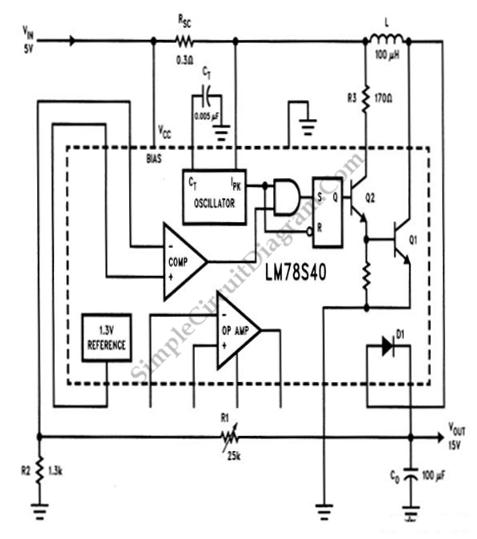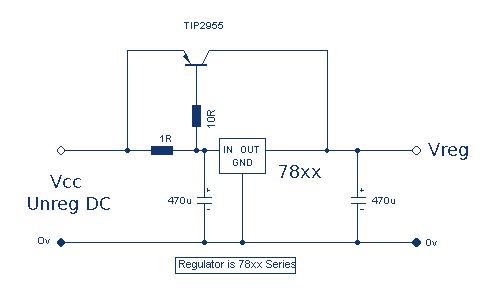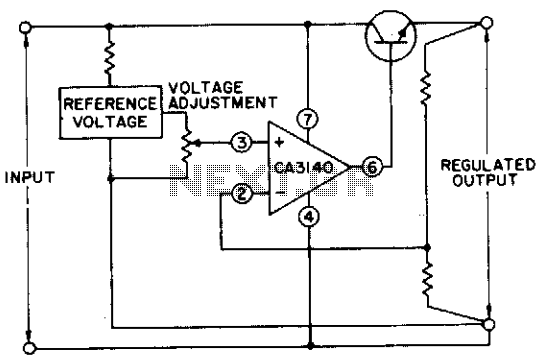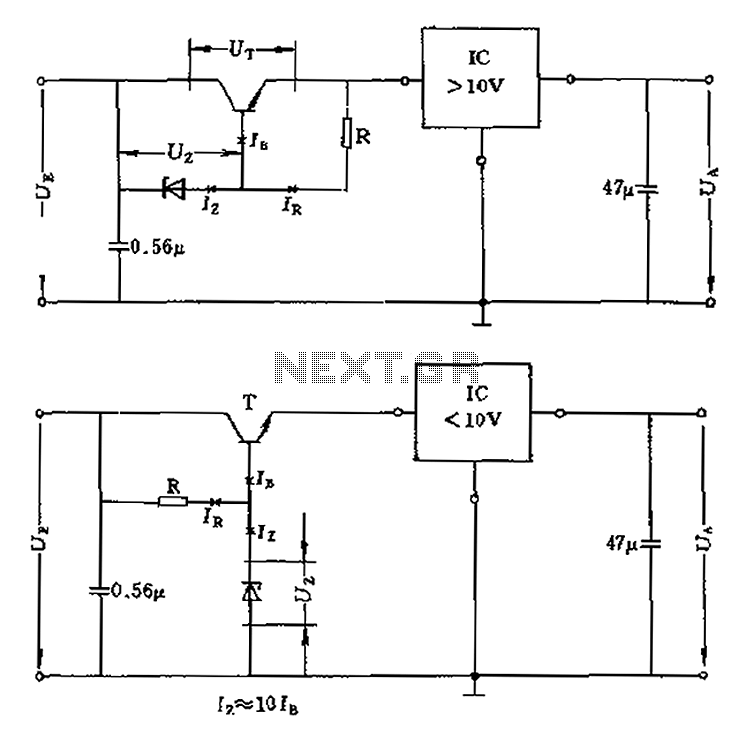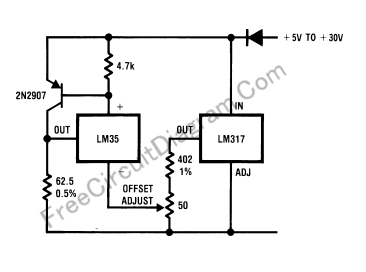
HV REGULATOR WITH FOLDBACK CURRENT LIMITING
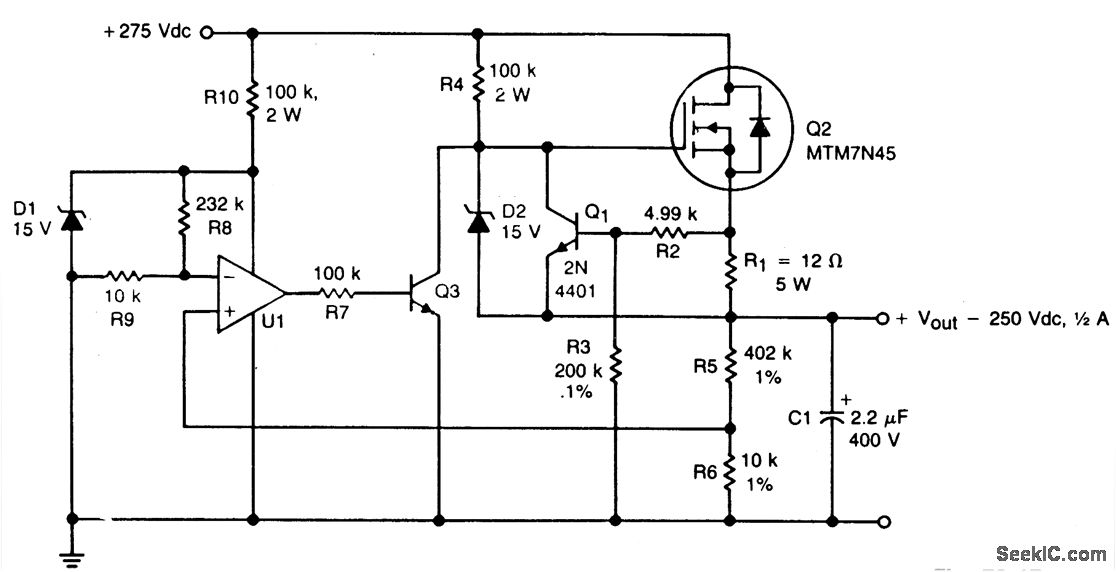
A TMOS MTM7N45 (Q2) functions as a series pass element in a linear high voltage supply that accepts +275 V unregulated input and produces a regulated output of 250 V, incorporating foldback current limiting. A 15 V zener diode, D1, supplies the DC reference for operational amplifier U1, which receives its other input from a portion of the output voltage. Operational amplifier U1 drives transistor Q3, which in turn drives the gate of Q2. Foldback current limiting is implemented through resistors R1, R2, R3, R4, transistor Q1, and diode D2. The formula to establish the current "knee" for limiting is:
The circuit employs a TMOS MTM7N45 transistor as the primary series pass element in a linear high voltage power supply configuration. The design is capable of accepting an unregulated input voltage of +275 V and regulating it down to a stable output voltage of 250 V. This regulation is crucial for applications requiring precise voltage levels, especially in high-voltage environments.
The operational amplifier U1 plays a significant role in maintaining the output voltage by comparing a fraction of the output voltage to the reference voltage provided by the 15 V zener diode D1. This feedback mechanism ensures that the output remains stable despite variations in load or input voltage. The operational amplifier's output is connected to the base of transistor Q3, which acts as a driver for the gate of the TMOS MTM7N45. This arrangement allows for efficient control of the pass element, enabling it to adjust its conduction based on the feedback received.
To enhance the reliability of the power supply, foldback current limiting is incorporated into the design. This feature prevents excessive current from flowing through the pass element, thereby protecting both the circuit and the load. The foldback current limiting circuit consists of resistors R1, R2, R3, R4, transistor Q1, and diode D2. These components work together to sense the output current and adjust the gate voltage of the TMOS MTM7N45 accordingly. The limiting action is characterized by a "knee" in the current output, which can be calculated using a specific formula that defines the threshold at which the current limiting begins to take effect.
Overall, this high voltage linear power supply design exemplifies a robust approach to voltage regulation and current limiting, ensuring that the output voltage remains stable and safe for connected loads, while also protecting the circuitry from potential damage due to overcurrent conditions.A TMOS MTM7N45 (Q2) is used as a series pass element in a linear high voltage supply that accepts +275-V unregulated and produces 250 V regulated with foldback current limiting. A 15-V zener, D1, provides the dc reference for operational amplifier U1, whose other input is obtained from a fraction of the output voltage.
UI drives Q3, which drives t he gate of Q2. Foldback current limiting is achieved by RI, R2, R3, R4, Q1, and D2. The formula to estab!ish the current "knee" for limiting is: 🔗 External reference
The circuit employs a TMOS MTM7N45 transistor as the primary series pass element in a linear high voltage power supply configuration. The design is capable of accepting an unregulated input voltage of +275 V and regulating it down to a stable output voltage of 250 V. This regulation is crucial for applications requiring precise voltage levels, especially in high-voltage environments.
The operational amplifier U1 plays a significant role in maintaining the output voltage by comparing a fraction of the output voltage to the reference voltage provided by the 15 V zener diode D1. This feedback mechanism ensures that the output remains stable despite variations in load or input voltage. The operational amplifier's output is connected to the base of transistor Q3, which acts as a driver for the gate of the TMOS MTM7N45. This arrangement allows for efficient control of the pass element, enabling it to adjust its conduction based on the feedback received.
To enhance the reliability of the power supply, foldback current limiting is incorporated into the design. This feature prevents excessive current from flowing through the pass element, thereby protecting both the circuit and the load. The foldback current limiting circuit consists of resistors R1, R2, R3, R4, transistor Q1, and diode D2. These components work together to sense the output current and adjust the gate voltage of the TMOS MTM7N45 accordingly. The limiting action is characterized by a "knee" in the current output, which can be calculated using a specific formula that defines the threshold at which the current limiting begins to take effect.
Overall, this high voltage linear power supply design exemplifies a robust approach to voltage regulation and current limiting, ensuring that the output voltage remains stable and safe for connected loads, while also protecting the circuitry from potential damage due to overcurrent conditions.A TMOS MTM7N45 (Q2) is used as a series pass element in a linear high voltage supply that accepts +275-V unregulated and produces 250 V regulated with foldback current limiting. A 15-V zener, D1, provides the dc reference for operational amplifier U1, whose other input is obtained from a fraction of the output voltage.
UI drives Q3, which drives t he gate of Q2. Foldback current limiting is achieved by RI, R2, R3, R4, Q1, and D2. The formula to estab!ish the current "knee" for limiting is: 🔗 External reference
